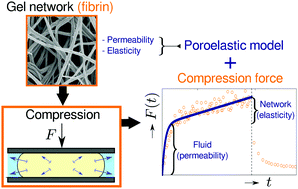Poroelasticity of (bio)polymer networks during compression: theory and experiment†
Abstract
Soft living tissues like cartilage can be considered as biphasic materials comprising a fibrous complex biopolymer network and a viscous background liquid. Here, we show by a combination of experiment and theoretical analysis that both the hydraulic permeability and the elastic properties of (bio)polymer networks can be determined with simple ramp compression experiments in a commercial rheometer. In our approximate closed-form solution of the poroelastic equations of motion, we find the normal force response during compression as a combination of network stress and fluid pressure. Choosing fibrin as a biopolymer model system with controllable pore size, measurements of the full time-dependent normal force during compression are found to be in excellent agreement with the theoretical calculations. The inferred elastic response of large-pore (μm) fibrin networks depends on the strain rate, suggesting a strong interplay between network elasticity and fluid flow. Phenomenologically extending the calculated normal force into the regime of nonlinear elasticity, we find strain-stiffening of small-pore (sub-μm) fibrin networks to occur at an onset average tangential stress at the gel–plate interface that depends on the polymer concentration in a power-law fashion. The inferred permeability of small-pore fibrin networks scales approximately inverse squared with the fibrin concentration, implying with a microscopic cubic lattice model that the number of protofibrils per fibrin fiber cross-section decreases with protein concentration. Our theoretical model provides a new method to obtain the hydraulic permeability and the elastic properties of biopolymer networks and hydrogels with simple compression experiments, and paves the way to study the relation between fluid flow and elasticity in biopolymer networks during dynamical compression.



 Please wait while we load your content...
Please wait while we load your content...